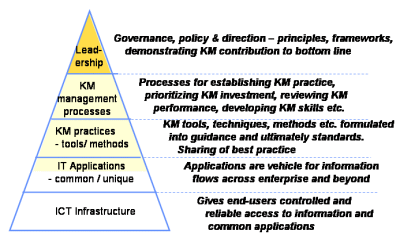KM Capabilities
An important part of the the analysis and assessment phase is determining what KM capabilities (knowledge, skills and experience) you have in your organization. In order to do this, you will need:
- A framework or model - to define the key capabilities you want to assess
- An assessment tool, such as a questionnaire or checklist to gauge the depth and breadth of capabilities
We have three frameworks and associated tools that we use:
- A generic KM framework. This will shortly be added to the KM Basics pages.1 The associated tool is the KM Assessment. Currently only the short version is available in our archive - see Know-All 10: A Quick KM Assessment.
- A KM Capabilities Model (see below). The Quick KM Assessment also maps into this model.
- A KM Maturity model - see KM Maturity Curve. This is a quick way of assessing your level of maturity against 'world-class' but is no substitute for tailoring a KM Capabilitiy model for your own purposes. We shall shortly be adding a Quick KM Maturity Assessment to our toolset.
KM Capability Model

The diagram shows our generic KM Capabilities Model which has been adapted and used in a range of consulting assignments. In outline, the five layers are as follows (from top to bottom):
- Leadership - this covers top level positioning of KM; how well it is integrated into the organizations high level decision making; to what extent are their clear and well communicated policies and principles that oversee the management and contribution of KM?
- KM Management processes - this covers the management of the KM function, whether it is part of a central unit or distributed throughout the organization; what level and depth of KM specialist skills exist; how well is KM organized and managed for the benefit of the organization?
- KM Practices - this is the heart of the capability assessment; it should assess the extent of use of various KM practices, both those involving information stores and their accessibility (how quick and easy is it for everyone to find the information they need?); what practices are widely used for sharing tacit knowledge?
- IT Applications - this is not only packaged applicaitons but end-user computer tools that can boost individual productivity, everything from mind-mapping tools to content management systems and more in between (including the use of wikis)
- ICT Infrastructure - essentially the underpinning networks and hardware used for access; can users access information at high bandwidth using a vareity of devices from a variety of locations (office, home, on the move) etc.
Like all such layered models, sometimes it is difficult to be precise as to where one layer ends and another begins, especially for the bottom two layers (covered in more detail in IT Systems Assessment). The key point of such a model is to get you to consider the range of factors in these different categories that comprise your KM capabilities. To assess capabilities you can use a variety of methods including questionnaires, document analysis, interviews, focus groups and statistical data. Whatever combination of methods are used it is important to get an assessment of:
- The existence (or otherwise) of a capability somewhere in the organization
- The extent of its use (where relevant) across the whole organization, i.e. breadth
- The quality and level (e.g. basic, advanced, world-class) of it use, i.e. depth
- Spread and variability of responses to the previous two assessments, i.e. degree of consistency.
As with other assessments in this section, data collected can be used to provide a benchmark for year-on-year comparisons of KM progress.
Note:
1. A version of this model can be seen in the archived article Knowledge Management: Making it Work.
Last updated: 19th March 2011


